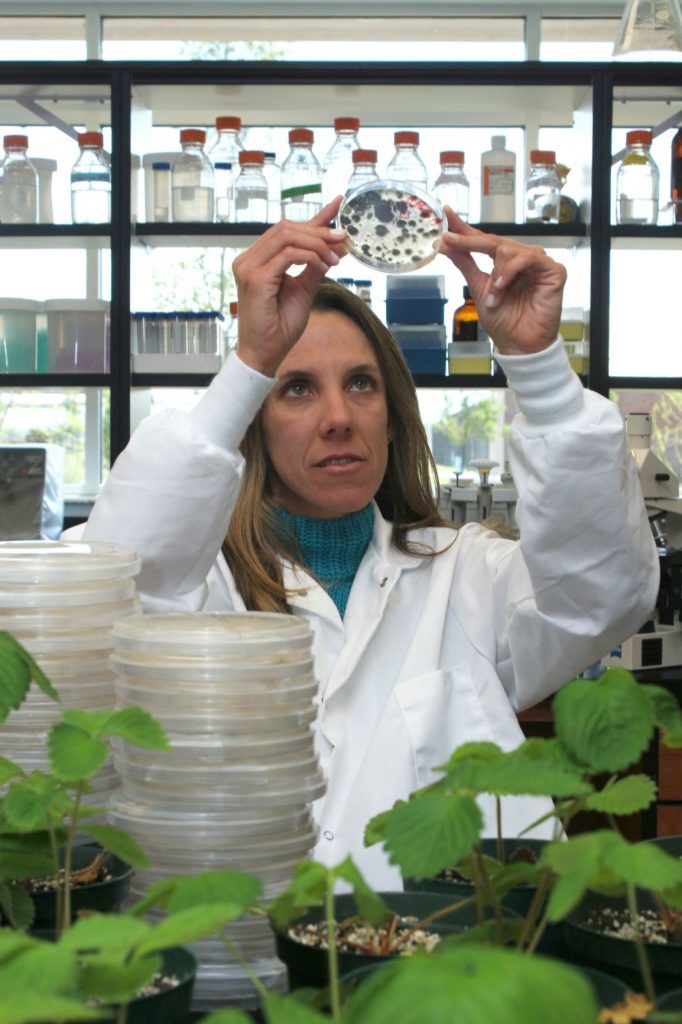
By: Brad Buck, 813-757-2224 (office); 352-875-2641 (cell); bradbuck@ufl.edu
Working at her lab and fields at the UF/IFAS Gulf Coast Research and Education Center, Natalia Peres diagnoses and helps manage diseases that might otherwise ruin strawberries, a $300 million per year crop in Florida.
In her efforts to beat back diseases, Peres helped develop the Strawberry Advisory System, which tells farmers when to spray fungicides on their crop to help them control botrytis and prevent anthracnose. Additionally, she’s participating in a collaborative effort with Cornell University – another land-grant institution — to use UV light to suppress strawberry pathogens.
Now, Peres has been named a fellow of the American Phytopathological Society (APS).
The APS grants the fellow honor in recognition of distinguished contributions to plant pathology or to the society. Fellow recognition is based on significant contributions in one or more of the following areas: original research, teaching, administration, professional and public service, and/or Extension and outreach.
“It is a tremendous honor to be among a select group of peers whom I greatly admire within the American Phytopathological Society,” said Peres, a UF/IFAS plant pathology professor. “I could not be happier with the recognition, and I am very thankful for the support I have always had from GCREC, the department of plant pathology and the strawberry growers.”
Peres always liked biology, but she wanted to apply her knowledge to food production. In fact, she didn’t gravitate toward plant pathology until she was in college in Brazil.
“During my doctoral program, I was working on a research project with a disease (post-bloom fruit drop) in citrus that was relatively new in Brazil, and there was not a lot of local information,” she said.
Pete Timmer, then a professor at the UF/IFAS Citrus Research and Education Center, was then the expert on post-bloom fruit drop, so Peres came to UF to do part of her Ph.D. research with Timmer.
“Working with him as a mentor completely changed my career and life path,” said Peres. “I am forever thankful for his mentorship and try to be the same model for my students as he was for me.”
David Gadoury, a senior research associate at Cornell University, nominated Peres for the honor. She’s worked with Gadoury for many years. In fact, he urged Peres to participate in the UV light research project.
“Peres is a superbly gifted and dedicated mentor of undergraduate, graduate, and postgraduate researchers,” Gadoury said in his nomination letter. “She has produced a generation of skilled and broadly trained researchers and crop advisors. Her commitment to mentor international students and postgraduate researchers is particularly notable.”
Peres has advised 27 undergraduate and 10 graduate and postgraduate researchers in her program since 2010. During the same period, her students received 24 awards from the APS Foundation, the University of Florida, and others, in recognition of their research and Extension achievements.
She earned all three of her degrees at Sao Paulo State University in Sao Paulo, Brazil. Peres’ bachelor’s degree is in agronomy and crop sciences, her master’s in horticultural sciences and her Ph.D. in plant pathology.
Peres came to GCREC as an assistant professor in 2004. She was promoted to associate professor in 2010 and made full professor in 2016. In that time, she has published 140 peer-reviewed journal articles.
Jack Rechcigl, director of the Gulf Coast Research and Education Center, and Peres’ on-site supervisor, said the center is fortunate and proud to have Peres as a faculty member.
“Her passion, energy and enthusiasm for her vocation has led her to become a world-renown pathologist who is recognized for her outstanding scientific contributions to the strawberry industry,” Rechcigl said. “Her productivity is boundless.”
Rose Loria, chair of the UF/IFAS plant pathology department and Peres’ supervisor in Gainesville, also lauded Peres.
“Natalia is dedicated to the strawberry growers she serves. Her ability to find innovative solutions to new disease problems or improve production practices to reduce inputs is outstanding – and she does this over and over,” Loria said. “I credit her collaborative style and her inherent creativity.”









